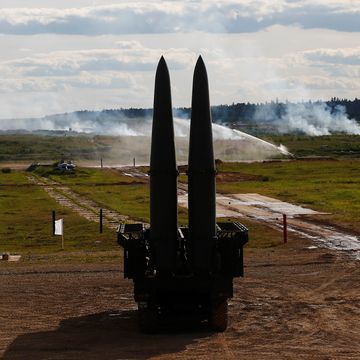A brand-new battlefield guided missile developed for the U.S. Army is being launched from an unlikely place—a grenade launcher. Developed by Raytheon, the Pike missile promises to give individual grunts the ability to hit targets more than a mile away.
For decades, U.S. Army infantrymen have been been stymied in their quest for greater firepower. Weight limitations, set by the average load a soldier can carry, put a limit on the number of bullets and grenades that can be carried into battle. The Pentagon's solution has been to make individual munitions smarter, so each hits the target the first time.
That's where the Pike comes in. This is a 40-millimeter laser-guided missile that weighs less than two pounds and measures just 16.8 inches in length, but manages to pack into that frame a rocket motor, guidance system, and laser seeker. Raytheon says the new weapon can be used against stationary and slow-moving targets out to 2,300 yards. Pike can be used not only against enemy soldiers in trenches and bunkers, but also against vehicles and even hovering helicopters.
In battle, Pike would be assigned to two-man teams. Missiles would be issued to the squad grenadier, the soldier carrying a M320 grenade launcher (in another space-saving move, Pike reuses an existing launcher). The second team member is equipped with a pistol-sized laser designator to mark the target.
The grenadier fires the grenade launcher, which launches Pike out of the barrel. Eight to ten feet away the missiles rocket motor—designed to produce a minimum of smoke—kicks in and sends Pike downrange. Pike detects the laser beam and homes in on it, and is reportedly accurate to within five meters.
If the Army decides to field the weapon, then Pike will occupy the middle ground between light mortars and heavier anti-tank missiles such as the Javelin. On the low end of that range, the M224 60-millimeter mortar is designed to drop a grenade-sized round on the enemy, but may require multiple rounds to get "on target." In the meantime, the enemy will take cover and the mortar's effectiveness will be reduced. Lacking a long-range weapon, American infantry in Iraq and Afghanistan have used Javelin anti-tank missiles against particularly stubborn targets. While a great missile capable of killing tanks up to two kilometers away, Javelin is heavy and—at more than $200,000 each—very expensive.
Pike appears to bring best of both worlds. Pike has the lethality of the mortar and the range and precision capability of the Javelin. At five pounds, including grenade launcher and one missile, Pike is nine times lighter than either.
First though, some issues need to be ironed out. The M320 grenade launcher needs to be modified accommodate the Pike. Five-meter accuracy is not that great for a precision weapon with a small warhead, but it's not awful, either. The real potential deal-killer is the pricetag: Raytheon hasn't disclosed the per-missile cost, which is likely to be much, much higher than the $70 cost of your average 40-millimeter grenade. Still, if it works out, Pike will be the first new, really useful weapon for grunts fielded in decades.

Kyle Mizokami is a writer on defense and security issues and has been at Popular Mechanics since 2015. If it involves explosions or projectiles, he's generally in favor of it. Kyle’s articles have appeared at The Daily Beast, U.S. Naval Institute News, The Diplomat, Foreign Policy, Combat Aircraft Monthly, VICE News, and others. He lives in San Francisco.














